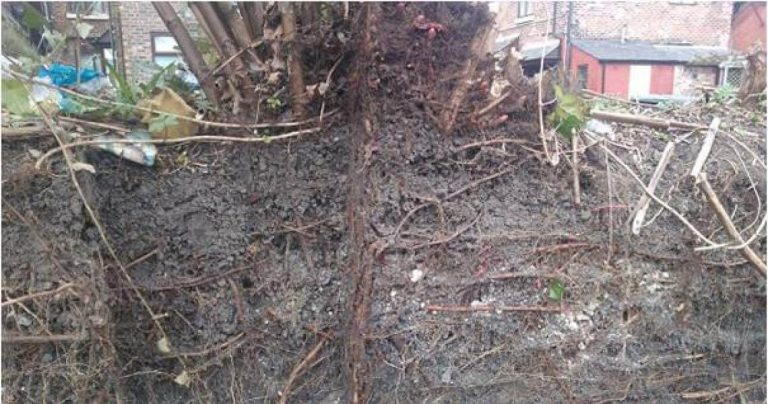
Blog
Problems with Re-Growth…?
Author: Mike Clough
Date Posted: Wednesday 5th August 2015

0161 723 2000
8AM to 5PM

Author: Mike Clough
Date Posted: Wednesday 5th August 2015

We are pretty good at what we do here at Japanese Knotweed Solutions, we’re pretty good… but we aren’t perfect…. and we do get re-growth on some of our sites.
I’m sorry if that shocks or offends you in any way but its true….and it’s one of the reasons why the infamous Japanese Knotweed is so problematic.
What I should emphasise here is that we aren’t being telephoned by clients all over the country complaining about re-growth on their sites – in every instance we have been aware of the situation and have been pro-active in resolving the situation.
But why does this happen?
Quite often the re-growth will be the result of what’s called ‘cross contamination’ – this is where somebody (usually unaware of the JK infestation) drives through the growth or moves material containing fragments of viable material – these pieces of JK are often not visible on a visual inspection hence are not included in any treatment programme.
Re-growth can also come from simply missing a piece of rhizome within the excavation process. Japanese Knotweed grows on average 1 to 2 metres in depth and between 2 and 7 metres outward from the visible surface growth.
Just look again at those figures that I’ve just quoted….an ‘average’ of 1 to 2 metres and ‘between’ 2 and 7 metres out from visible surface growth…that’s a pretty large variation…and that’s before you include that it can go as deep as 3 metres and has been known to travel over 20 metres from surface growth.
There is also discrepancy between advice from the various Agencies involved with the legislation that covers JK. The Environment Agency note that excavations should be kept as minimal as possible while SEPA the Scottish version of the EA make a comment that excavations should be overstated the ensure that all rhizome is removed.
You must then also include within these variables the fact that in most cases the ‘client’ wishes for minimal cost impact on their project ….and will want the lowest price for the works –
It simply isn’t possible to ‘see’ beneath the ground ….hence when pricing a ‘muck away’ project one is taking an educated… ‘guess’… yes, yes… we have done this type of project loads of times and ‘yes’ in most cases our educated ‘guess’ is pretty damn accurate…but just occasionally there can be a random piece of growth that just doesn’t conform to any industry standard….and low and behold you get re-growth where there shouldn’t be any!
So… re-growth on a removal from site project is … ‘understandable’…not good but ‘understandable’.
What about the sites that we’ve been chemically treating for years where the Japanese Knotweed simply refuses to die?
We have worked on Japanese Knotweed projects for over fifteen years and NOBODY has more experience than us…yet I would say we are still learning.
We were the company that first used Tordon 22K the chemical that became the industry standard until it was withdrawn from sale earlier this year.
We have tried every version of Glyphosate that has been produced …and continue to be the referral point of several of the chemical manufacturers when they are launching a new product.
We were offered the sole rights to the direct injection system when it was first launched – but following trials – we declined.
We have sprayed small sites, we have sprayed medium sized sites and we have sprayed miles of river frontage…and we have learned a thing or two as we have developed our strategies.
What time of year should chemicals be applied…? What about weather conditions…? What about global warming…?
I kid you not (or ‘Knot’…) all of these factors will play a part in the efficacy of the chemical treatment process.
Boredom …will also play a major part in whether a treatment plan is successful..! Again – I kid you not…..
Can you imagine having to spray miles…. and literally miles of established Japanese Knotweed…year after year…application after application. How do you keep your teams motivated?? Its bloody soul destroying to spend weeks applying chemicals to a river frontage which when you come back six months later – looks like you haven’t been to site.…EVER…
Repeat applications of herbicide will eventually get on top of serious knotweed growth – but it can be a very long process…often punctuated by clients ringing saying ‘there’s re-growth’…to which we respond ‘yes’ we know…we are on top of the situation.
We have also had sites where due to poorly applied herbicidal treatment from previous contractors – the Japanese Knotweed has simply gone into what’s called ‘dormancy’. This basically means the plant is just sitting there until some physical change causes a new spurt in growth. This can happen randomly following a very wet summer or perhaps an unseasonal warm spell.
Anybody who works in the field of invasive species management will have had re-growth on their sites….(I f they say this has never happened…. they are lying)…
What other companies DON’T have – is a re-visit team or as is the case with Japanese Knotweed Solutions….RE-VISIT TEAMS
We DON’T lie about re-growth problems, we ACCEPT them as part of the issues with Japanese Knotweed management and we do something about it.
We DON’T wait for clients to ring us – we are already all over the problems.
Mike C